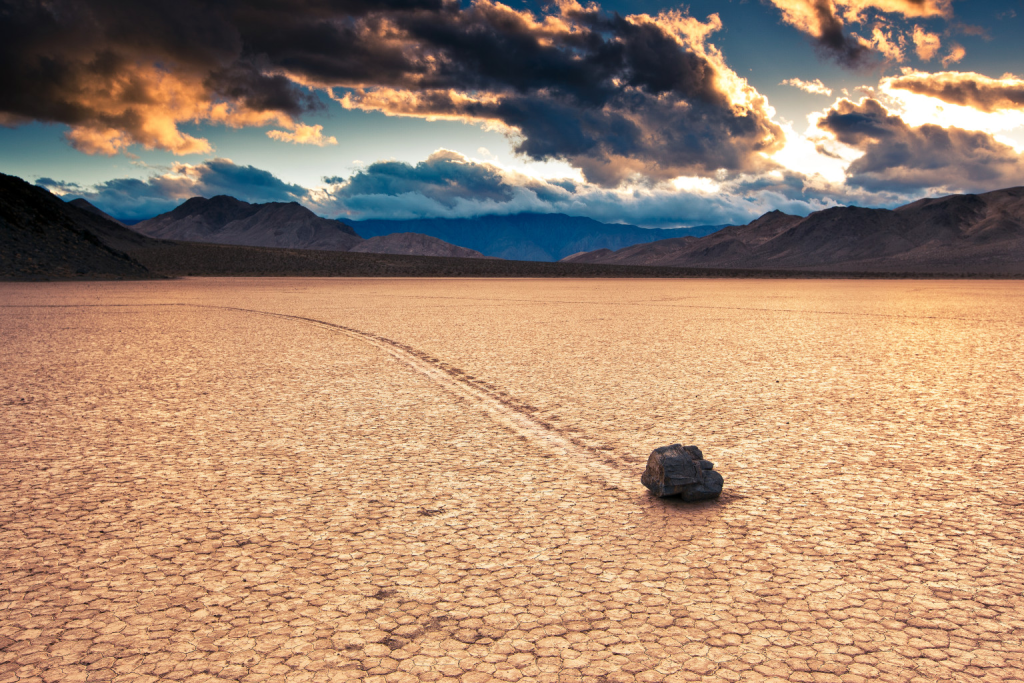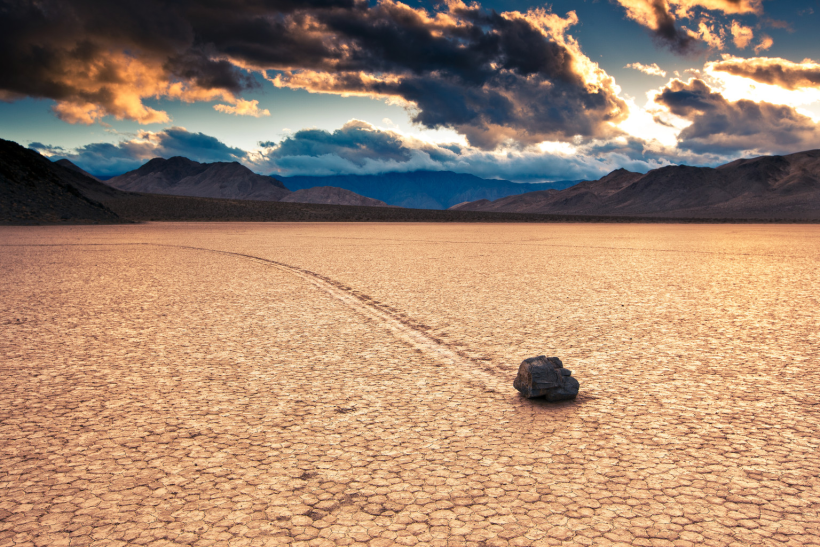
It’s Spring Break and you decide to take a trip with your friends to Death Valley before school starts back up. When you get there, you gaze out across the vast dry lake bed that spans scenic Racetrack Playa. In the distance you see a few dark objects in the middle of nowhere. Curious, you walk closer to one of the dark shapes, only to find a 500 pound rock in the middle of the lake bed. You scratch your head and look around. No sign of how the rock got here other than a shallow track trailing out from the rock some 200 ft or so.
How in the world did this rock get here?
This question is one that tourists & travelers, explorers, scientists, and curious people from all over the world have been asking themselves for over a century. Many theories have been proposed & there is no shortage of folklore surrounding these “sailing stones”. Some believe the rocks are moved by tiny microorganisms much as ants move leaves, while others propose that it is an affect caused by Earth’s magnetic field, while still others postulate that the only reasonable explanation is action by extraterrestrial life forms. More recently, however, a more scientifically sound explanation has arisen. After utilizing GPS trackers in combination with time-lapse photography, researchers have finally deduced the solution that has eluded us for so long.
During the rainy season, the dry lake beds in Death Valley begin to flood…but only partially, as is important for the validity of the new-found explanation. During the cold winter nights, the shallow layer of water over the lake bed freezes, locking the rocks within a matrix of newly formed ice sheet. As the sun rises, the lake bed begins to thaw out…but not all at the same rate, as can be explained through 2 avenues of causality. The first of these is because the rock presents more surface area in the vicinity (i.e. far removed from the rock the only surface is the ground, whereas at the rock there is the ground & all the surfaces belonging to the rock’s geometry)…because of this increased surface area (& because that surface area is relatively rough and porous), the rock provides more sites for nucleation/ice formation, leading to larger amounts, higher densities, and stronger networks of ice attached & near the rock than away from the rock. The second factor is that because the rock has a relatively large heat capacity & is very dense, it is typically much more difficult to thoroughly heat up the rock (& the surrounding ice) after a cold night than it is the dirt and the ice far removed from the rock. Thus, owing to these two factors, the ice near the rocks tends to take longer to melt than the ice away from the rocks.
As the ice thaws & melts, the rocks become isolated in their own little ice patches (only a few millimeters thick from top to bottom) in a sea of shallow water on top of a soft, yet slick clay floor. Due to the combination of slightly increased buoyancy due to the ice (which tends to float on water, but is counteracted to a great degree by the dense rock) & the favorably low-friction clay floor & water film cushioning the ice, the resistance to movement of the rocks is significantly lowered. With the very strong winds typical in great open spaces like the lake bed, one great gust can set the ice sheet & its embedded rock in motion, at which point (as any beginning level dynamics student can tell you) the associated coefficient of friction between rock & lake bed drops from its relatively high motion-threshold static value to its lower kinetic value. So long as the wind is sustained at a high enough speed (& assuming the ice sheet is strong enough to not break up), the rock will continue to move under its influence, softly carving up the lake bed, often changing directions with the wind, sometimes gradually, sometimes sharply owing to the change in wind direction occurring in between sailing events.
Eventually the weather begins to get warmer & the lake bed ceases to flood & freeze over and tourists are met with the ever-puzzling enigma of the sailing stones of Death Valley.

